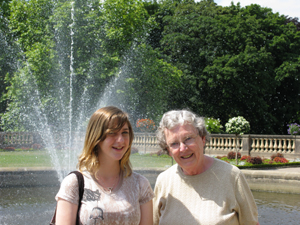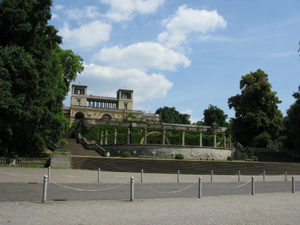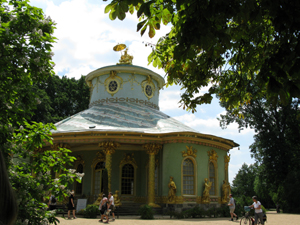Our terrific transportation passes brought us to Potsdam by train, where we transferred to a bus
 Entrance to Sanssouci
which dropped us off at the base of the grounds of King Frederick the Great's palace. We were in a part
of Germany which was controlled by the Soviet Union from the partition after World War II until its collapse
in 1990-91. The furnishings of Sanssouci were relocated during the Berlin air raids, but the buildings
experienced only minor deterioration during the post-War years. Sanssouci was nominated as a World
Heritage Site by the East German government, and so designated in 1990.
Entrance to Sanssouci
which dropped us off at the base of the grounds of King Frederick the Great's palace. We were in a part
of Germany which was controlled by the Soviet Union from the partition after World War II until its collapse
in 1990-91. The furnishings of Sanssouci were relocated during the Berlin air raids, but the buildings
experienced only minor deterioration during the post-War years. Sanssouci was nominated as a World
Heritage Site by the East German government, and so designated in 1990.
Sanssouci consists of a large hilltop park with many royal buildings, guest houses, temples, follies, and even a royal waterworks;
Frederick had purchased a property without a natural source of water and thus had to devise a means of bringing water for
 Enjoying a fountain
his palace and gardens. We had thought Monday was the day of museum closures, but in fact several of Sanssouci's
buildings were closed on Tuesday. Still there was more than enough to see and do in a single day. This was
one of the warmest days we experienced in Europe, and we were grateful for the shaded walkways of the park.
Enjoying a fountain
his palace and gardens. We had thought Monday was the day of museum closures, but in fact several of Sanssouci's
buildings were closed on Tuesday. Still there was more than enough to see and do in a single day. This was
one of the warmest days we experienced in Europe, and we were grateful for the shaded walkways of the park.
Sanssouci is often compared to Versailles in splendor, but our impression was more of a royal retreat than
a palace to dazzle foreign guests. The intellectual Frederick thought of the palace as "mein Weinberghauschen" - my little
vineyard house - and intended it for his personal and private pleasures.
 The Orangerie from the park.
Sanssouci Palace is a long narrow building, in a large park. Frederick used it as a retreat from his official duties and enjoyed designing and overseeing
its development. In addition to Sanssouci itself, we visited the palace kitchens, the New Palace, which contains additional rooms
for guests and entertaining, and the Chinese House, a folly built in the park, decorated with gilded figures and featuring
a gilt mandarin holding an umbrella on its roof. We also walked by the Orangerie, which is closed while undergoing a complete
restoration.
The Orangerie from the park.
Sanssouci Palace is a long narrow building, in a large park. Frederick used it as a retreat from his official duties and enjoyed designing and overseeing
its development. In addition to Sanssouci itself, we visited the palace kitchens, the New Palace, which contains additional rooms
for guests and entertaining, and the Chinese House, a folly built in the park, decorated with gilded figures and featuring
a gilt mandarin holding an umbrella on its roof. We also walked by the Orangerie, which is closed while undergoing a complete
restoration.
In the two palaces we were given audioguides which accompanied us, room by room, on our tours.
We learned that
Voltaire was the king's bosom companion and frequently visited the palace, and we learned about some of the different
styles of decoration (mostly rococo) in the rooms, which consisted of a few rooms for entertaining and receiving visitors
 The Chinese House
and quite a number of rooms occupied for long periods of time by guests. Frederick also entertained members of the Prussian Academy
of Sciences here. The library, which contains some 2,000 leatherbound volumes in
Greek, Latin, and French, is not open to tourists. But on display is a painting depicting Frederick playing the flute in
the music room, which gives a clear impression of the intimacy and style of Sanssouci.
The Chinese House
and quite a number of rooms occupied for long periods of time by guests. Frederick also entertained members of the Prussian Academy
of Sciences here. The library, which contains some 2,000 leatherbound volumes in
Greek, Latin, and French, is not open to tourists. But on display is a painting depicting Frederick playing the flute in
the music room, which gives a clear impression of the intimacy and style of Sanssouci.
The grounds are so large, and there are so many paths, that it would be easy to spend an entire day just walking under
tall old trees past occasional formal gardens and fountains. When we found the Chinese House we were happy to spend
some time admiring the gilt figures and stepping inside the marble-floored room. We tried to imagine tea parties here,
with ladies and gentlemen in formal attire, surrounded by servants. On top of the roof sits a life-size gilt mandarin,
 Schinkel refused to come
holding an umbrella.
Schinkel refused to come
holding an umbrella.
One treat was to stumble upon the Movenpick restaurant nestled in one corner of the park. We sat outdoors under an umbrella,
enjoying mild breezes, and delicious food, including ice cream for dessert.
The tourist info told us that we had a chance to catch a river tour that afternoon, so we abandoned the park and grabbed a
city bus to the river's edge where we enjoyed a leisurely cruise up the broad Havel River. This river is filled with recreational
visitors, some in houseboats and others camping or playing on the shores. We passed a number of small palaces which had been built
by German nobility, mostly in the 19th century. Some are in use today as casinos or hotels, others may still be privately owned.
One imposing building was the result of a disagreement between the then empress and her architect. She had retained the most
 The church at Sacrow
famous architect of his time, Karl Schinkel, who designed a classically-styled palace. However, she had a passion for English
Tudor architecture, and the resulting hodge-podge so enraged the architect that he insisted his name be removed from any association
with the building.
The church at Sacrow
famous architect of his time, Karl Schinkel, who designed a classically-styled palace. However, she had a passion for English
Tudor architecture, and the resulting hodge-podge so enraged the architect that he insisted his name be removed from any association
with the building.
Another building which caught our eye was the church in the little village of Sacrow, built during the reign of the fourth King
Frederick. Even though it looks mysterious and ancient, it actually dates from the 1840s and was the church where the King
worshipped. It was designed to reflect the romanticism of German thought and architecture of that period, to appear as though
it were an old ship gone aground. What we didn't know until we returned home was that when Germany was partitioned, the boundary
ran right through the church property. The bell tower itself was built into the Wall because it provided good views for marksmen.
The church was used for worship until Christmas 1961. A few days later, vandals destroyed the church's interior; the government
then sealed the building and made it fully a part of the border wall. Since reunification, the church has been largely restored.
 Entrance to Sanssouci
which dropped us off at the base of the grounds of King Frederick the Great's palace. We were in a part
of Germany which was controlled by the Soviet Union from the partition after World War II until its collapse
in 1990-91. The furnishings of Sanssouci were relocated during the Berlin air raids, but the buildings
experienced only minor deterioration during the post-War years. Sanssouci was nominated as a World
Heritage Site by the East German government, and so designated in 1990.
Entrance to Sanssouci
which dropped us off at the base of the grounds of King Frederick the Great's palace. We were in a part
of Germany which was controlled by the Soviet Union from the partition after World War II until its collapse
in 1990-91. The furnishings of Sanssouci were relocated during the Berlin air raids, but the buildings
experienced only minor deterioration during the post-War years. Sanssouci was nominated as a World
Heritage Site by the East German government, and so designated in 1990.
 Enjoying a fountain
Enjoying a fountain The Orangerie from the park.
The Orangerie from the park. The Chinese House
The Chinese House Schinkel refused to come
Schinkel refused to come The church at Sacrow
The church at Sacrow